“The government is covering its ears and stealing the bells and blocking the mouth”
—
Since the COVID outbreak in Tibet began on August 7, 2022, Tibetans and Chinese tourists in the region have been suddenly caught up in lockdowns with little sign of the situation improving in the short term. Chinese authorities were seemingly caught off guard by the sudden outbreak of COVID in the area.
The Chinese government’s denying of access for independent journalists and observers to occupied Tibet have exacerbated the problem of gauging the severity of the outbreak in Tibet. Chinese state media reporting on the outbreak in Tibet has largely portrayed a picture of the situation being under control and praised the government’s performances in curbing the virus. Due to the lack of meaningful data and independent reporting from the ground, the International Campaign for Tibet (ICT) has relied on Chinese social media and other digital communication channels to gauge the reality of COVID in Tibet.
An analysis of the complaints posted by Tibetans and Chinese on the internet depict a situation far worse than the performance picture painted by the Chinese state propaganda apparatus, which is attempting to shape public opinion with two central messages: COVID in Tibet is a foreign import, and public goods for the Tibetans are being delivered amidst the government’s implementation of a Zero COVID strategy.
Foreign origin of BA. 2.76 in Tibet?
In advancing the state narrative of COVID being a foreign import in China, the Chinese government pointed out that the Tibetan cities had been hit with BA.2.76, the third generation subvariant of Omicron’s BA.2. The government claimed that the subvariant had not been detected in China until then. Parsing through the subtlety of the message, authorities apparently implied that the COVID outbreak in Tibet was a foreign import.
China’s state media quickly zeroed in on Samdruptse district in Shigatse (Chinese: Rikaze) as the ground zero of COVID outbreak in Tibet. Since Nepal, India and Bhutan shares land borders with Shigatse, Chinese state media under the control of the party state’s propaganda department blamed the subvariant Omicron as a foreign import both implicitly and explicitly.
China’s state media, among them the Global Times, in its messaging implied the possibility of COVID imported via Nepal, India and Bhutan. Two main trading points with Nepal – Tatopani and Rasuwagadhi – were shut down. At least one Chinese media explicitly pointed at Nepal and India as the possible originating point of Omicron BA. 2.76 in Tibet.
However, the Chinese language news site Health Times reported on August 28 that although the BA.2.76 variant was first reported from Lhasa, it said since then “Shanghai, Chongqing, Chengdu in Sichuan, Shenyang and Benxi in Liaoning, Hangzhou and Wenzhou in Zhejiang, Shijiazhuang in Hebei, Longxi County in Dingxi, Gansu, Guangzhou in Guangdong, Fuzhou and Xiamen in Fujian, Kunming in Yunnan, and Shanxi, Shaanxi and Qinghai” have all reported the discovery of the BA.2.76 subvariant. Whether these cases were brought from the Tibetan cities or were separately publicly reported can only be known through thorough investigations.
Performative governance for Zero-COVID strategy
To assuage public opinion at the failure of authorities in preventing COVID outbreak in Tibet, China’s propaganda apparatus depicted stringent anti-COVID measures being adopted to curb the outbreak, top medical services being provided and no-hindrance supply of essential commodities.
Additionally, replicating the deployment of performative COVID prevention in the Chinese towns and cities, trucks spraying streets with disinfectant were also deployed in Tibet although the medical value of the practice is doubtful and not recommended by the World Health Organization.
Another performative COVID prevention was to dispatch health officials in personal protective equipment suit riding horses to administer COVID test in remote locations where a single nomadic family may well be the only family in the whole valley. In some propaganda videos, a rider with the party’s hammer and sickle red flag leads a team of hazmat suit wearing health officials riding horses. These performative anti-COVID measures are useful for propaganda to depict officials and the party as heroes in the “tough battle against COVID”.
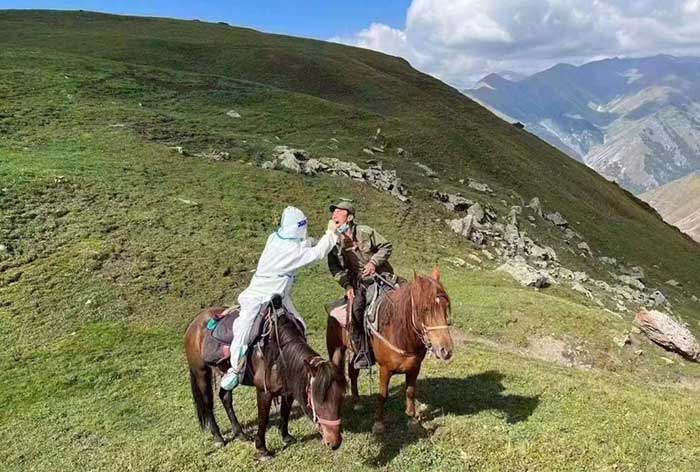
Zero-COVID measures are also accompanied by the assurances of medical service to COVID infected persons and the prompt supply of daily essential commodities to the public. Authorities frequently gave such assurances during official press conferences and through the state media. However, as the below messages from Tibet reveal, the reality is far from the rosy picture painted by official propaganda.
Filthy and service less isolation centers
Undeterred by official warning against “spreading rumors”, Tibetans and Chinese alike have publicly expressed their dissatisfaction with the government’s performance, with some issuing open criticism against the authorities.
Tibetans have openly expressed themselves on Chinese social media platforms like Weibo, WeChat, TikTok and via other digital communication channels. Select few are reproduced below.
One Tibetan woman in her social posting walks the viewers inside an isolation center in Lhasa. The woman speaking in Chinese shows a service-less, disorderly, and filthy isolation center with piles of trash and bricks and boards laid down to walk across a hallway flooded with toilet water.
Another Tibetan woman in her social posting pans around her isolation center in Lhasa showing rows of beds with patients and saying that the dusty floor worsens the patients and that there is no one to provide care to the patients.
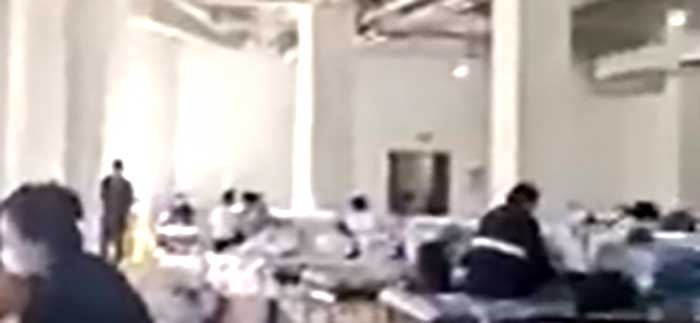
Similarly, a Tibetan man also pans his phone camera to show rows of patient beds commenting the lack of medical care for patients with fever. “All we do is stay here with no service whatsoever even when patients experience fever,” says the man.
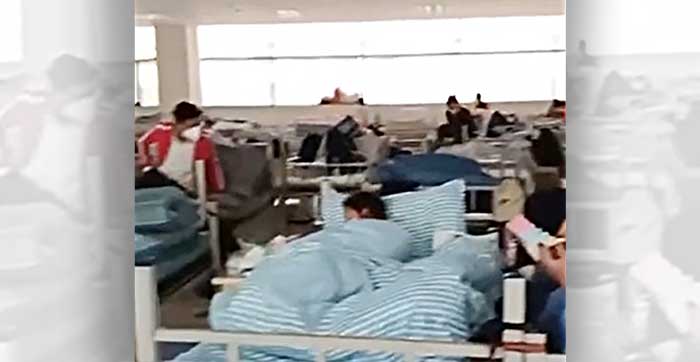
A Tibetan woman in Lhasa in her social post advises others to bring their own food and medicine supply if they are sent to isolation centers like her. Speaking in Tibetan, she says
If you receive a phone call [from the authorities] sending you to an isolation center, take along your own food supply. Once you are here, there is no one to care for you. The government said that food will be provided but no food is provided here. I called everywhere but there is no one sending us food. I pray that you are not sent to an isolation center but if you are then you should prepare to bring along your own supply of food and medicine as there is nothing provided here… I called 110 [emergency hotline], the municipal [Lhasa] government Epidemic Prevention and Control Hotline, the municipal government Epidemic Prevention and Control Unit, Chengguan district Epidemic Prevention and Control Unit, and all they said is that it does not concern them or they don’t know.
A Chinese man residing in Chengguan district in downtown Lhasa speaking in Chinese in his social post says,
There is severe shortage of grocery items here. 99% of the help phone numbers provided by the government is useless. They announce that food reserve is very strong, and supply would not be a problem. But there is no place to buy or where to buy [food]. It is very hard here and [the officials should] pay attention. There is danger of even grains getting cut-off.
Showing the severity of food supply shortage during the lock down, a netizen uploaded a video clip of a seemingly government supplied produce for distribution amongst the public. Standing near rows of paltry produce laid on the street, a Tibetan woman could be heard telling people to pick up the produce if they don’t have any left in their home.
Abuses by authorities
Abusive behaviors by the police and officials were captured on video and posted by Tibetan netizens complaining of heavy-handedness treatment. Owing to wide circulation of a video clip showing a Tibetan policeman beating another Tibetan, the authorities promised actions against the policeman owing to mass outrage on social media. Tibetan netizens identified the man in PPE suit as a Tibetan policeman notoriously known for manhandling people all the time and the victim as a herder who had come back in the town not knowing about the COVID outbreak while he was herding in the mountains.
In another video clip posted on Chinese TikTok, police and health officials manhandle a Tibetan woman sitting in a restaurant. Speaking in Tibetan, seemingly a health official tells the woman to show him her photo ID. When the woman ignores the official, a police officer in the team orders her to be taken away. Two policemen drag the resisting woman out of the restaurant and throw her into the police SUV.
In another video clip, a man is forcibly being taken away in a white van while a crying woman, probably a family member, runs towards the van. Another man shields the woman from the officials in hazmat suits and is heard saying “she has heart disease, she has heart disease.”
Stranded tourists and truckers
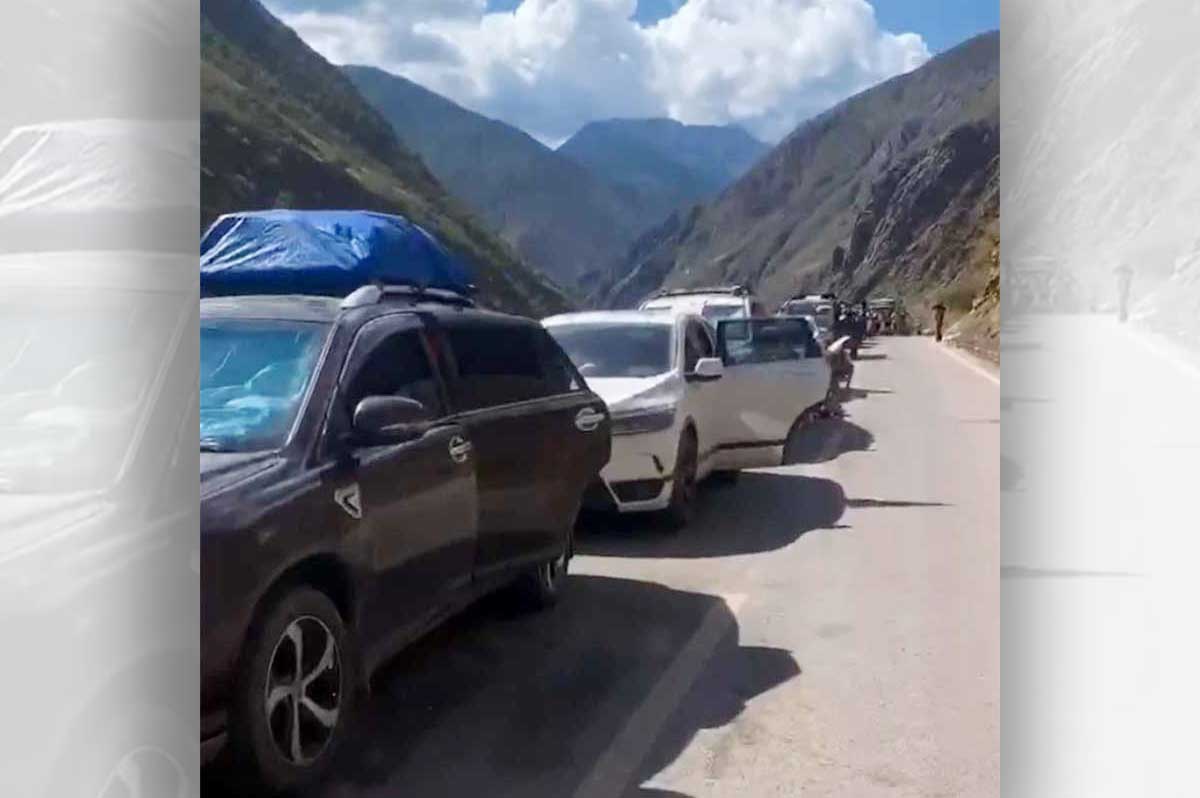
When the Chinese authorities put Tibetan cities under COVID lock down, hundreds of thousands of Chinese tourists trying to go back to their homes in China were stranded. Along with the tourists, truckers were also stranded at the border checkpoints by the sudden lock down beginning from August 7.
Speaking under the pseudonym Gobi Lao Wang and Li Muge, two Chinese tourists speak in detail the hardships Chinese tourists had to undergo being stranded on the road due to the sudden lockdown. While Gobi Lao Wang was trapped on the Yunnan-TAR border for five days and four nights on the way back to Yunnan, Li Muge was trapped in Shigatse shortly after entering Tibet. The stranded tourists recount of having to spent days and nights on the road with children wailing with fever and skin peeling from the sun, defecating in open-air toilets, drinking the government supplied single bottle of water and food, sleeping under or in the trunk of their vehicles, taking nucleic acid test every day on the road and spending 300 yuan per night out of pocket for the mandatory quarantine once they were released from the border checkpoint with a negative result.
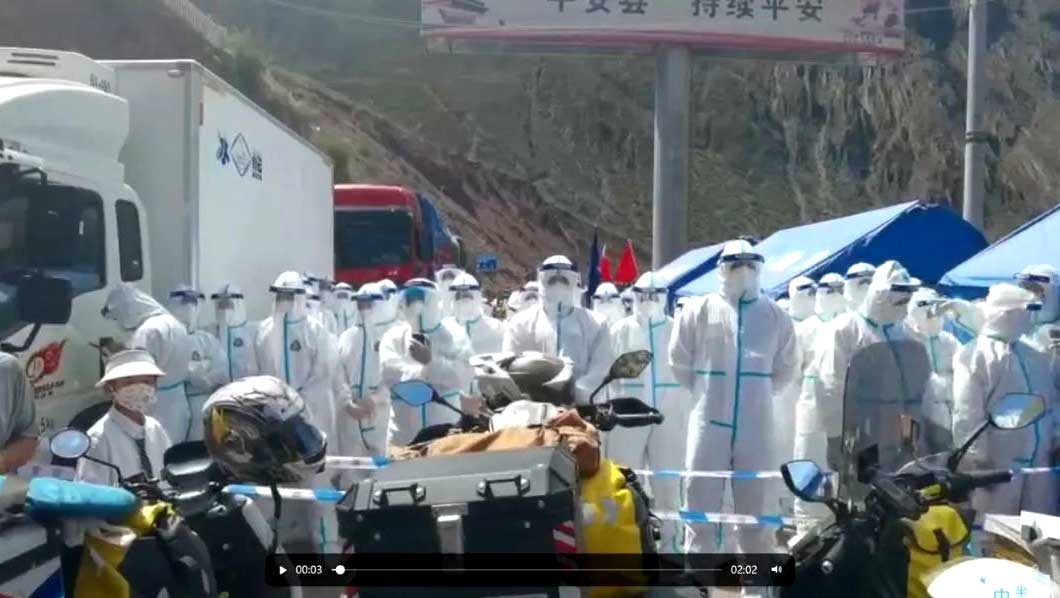
Chengguan district in Lhasa declared as “social zero”
Tired of abusive treatment during the COVID outbreak in Lhasa, Tibetans and Chinese netizens continue to express their opinion and criticism against the Chinese government’s poor handling of the outbreak.
When the Leading Group for Responding to COVID outbreak in Chengguan district declared the “happy news” of the district to be “social zero” – a term used for initial blockage of community transmission of new COVID cases – with accompanying external propaganda on August 29, frustrated Tibetans and Chinese netizens didn’t stop at expressing their opinions and criticisms against the government. They were frustrated at enduring all the hardships in the past three weeks due to the authorities’ unpreparedness for the outbreak, and poor and heavy handedness in controlling the spread.
Posting on Chinese social media Weibo, a netizen wrote
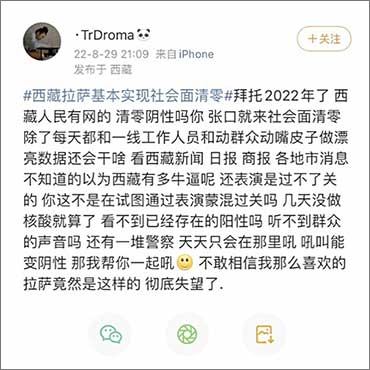
It is 2022. Tibetans can access the internet. What do you mean by “cleared the social dimension” and “no transmission”. Besides speaking in front of the work force and the public, what do you know except to present beautiful numbers. Look at the Tibetan news and the state media, will things get better through mere theatrics? Don’t you see how many have tested positive? Don’t you hear the voice of the public? If the police say all kinds of things, will it make the infected people negative? I too can speak all kinds of nonsense. I can’t believe my beloved Lhasa has become like this. I have lost all my hope.
Another comment on Weibo read
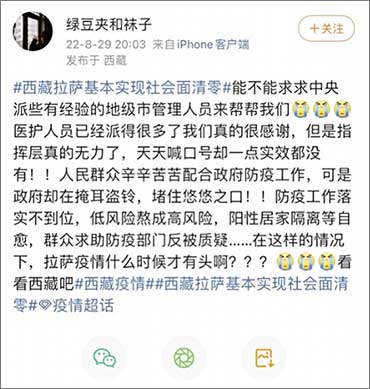
Can we request the government to send some experienced prefectural-level city managers to help us? A lot of medical staff have been sent and I am grateful for that. But those in the command level are inefficient. Besides shouting slogans every day, their work has no effect at all! People are working hard to cooperate with the government’s epidemic prevention work, but the government is covering its ears to steal the bells and blocking the mouth! The government is fooling itself and blocks the voice of the people. Because of inefficient epidemic prevention, low [COVID] risk areas have turned into high-risk area and the [COVID] positives had to isolate in their homes. When the public appeal for help to the epidemic prevention authorities, they raise suspicions on the public. Under such a situation, when will the epidemic in Lhasa become better?
Another critical comment on Weibo read
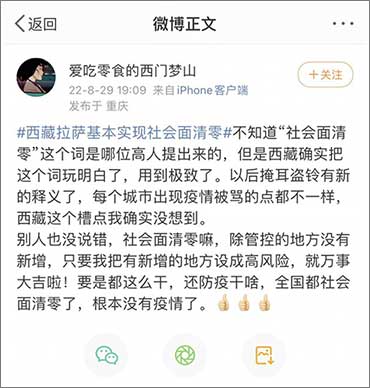
I don’t know which expert came up with the term “social zero” but the term has been used to the extreme. In the future there may be a new explanation for “Covering one’s ear and stealing the bell”. There is no mistake in what the others have said. If “social dimension is cleared” means no new transmission is detected in areas under tight control and other areas are designated as high risk where new cases are detected, does that mean that the work has been successful? If it continues like this, what is the use in announcing epidemic prevention? By declaring “cleared social dimension” throughout the country, does that mean that the epidemic has been eliminated?
A university student on learning the official declaration of Chengguan district as “Social Zero’ commented on Weibo stating
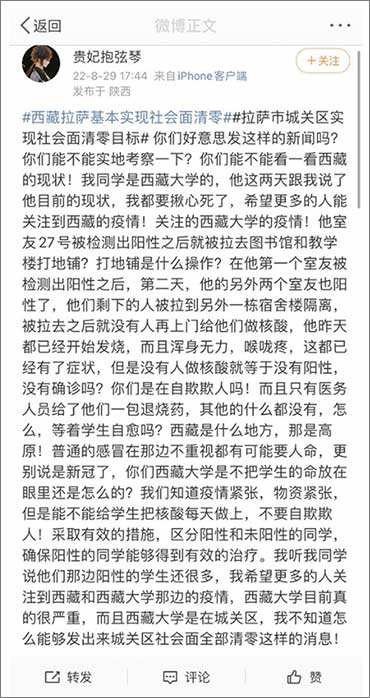
Aren’t you not embarrassed to make such a declaration? Can’t you come to the ground for assessment? Can you look at the current situation in Tibet? My classmate is from Tibet University and he shared to me his situation. I will die of sadness. I hope more people can pay attention to the epidemic situation in Tibet! I hope you can pay attention to the current situation in Tibet University.
After discovering that Tibet University student’s roommate being positive on the [August] 27th. Wasn’t he taken to the library and the upper floor classroom where he was isolated. After his first roommate tested positive, the next day, his other two roommates also tested positive. They were isolated in another upper floor room. After that no one came to give medical care to them. Since yesterday that student developed symptoms of fever, fatigue and sore throat but nobody came to do nucleic acid test, which means he is not positive, right? Aren’t you deceiving yourself? Besides antipyretics nothing was provided. What is this? Are you waiting for them to heal by themselves? Tibet lies on high altitude. It could be fatal if one does not care after even a cold. No doubt over COVID. Are you paying attention to the lives of the Tibet University students?
We know that the epidemic level in Tibet is high and supplies are tight. However, can’t you do daily nucleic acid test on the students? Don’t deceive yourself. Efficiently separate the positives from the negatives and provide medical care to the positives. I learned from my schoolmates that many students are positive. I hope that more attention is paid to the epidemic situation in Tibet and the Tibet University. Not only is the current situation at Tibet University extremely concerning, it [Tibet University] is in Chengguan district. That’s why I don’t understand how could you declare that [COVID in] Chengguan district is “cleared of social dimension”.

